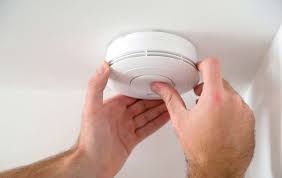Smoke alarms are a vital component of home safety, offering an early warning in the event of fire and providing individuals with the important seconds needed to evacuate safely.
Understanding the reasons behind the beeping or chirping of smoke alarms can significantly enhance your ability to maintain these devices properly and ensure they function when most needed.
Below, we look into the intricacies of why smoke alarms beep and provide detailed solutions to address these issues.
The most common reason your smoke alarm is beeping, is a low battery or insufficient power.
Why Smoke Alarms Are Important
Smoke alarms, whether battery-operated or hard-wired into your home’s electrical system, are designed to detect smoke and alert occupants with a loud alarm sound.
However, these devices can emit different types of beeping sounds, which are often misinterpreted or ignored. Recognizing the importance of these alerts and responding appropriately can be the difference between safety and impending danger.
The Language of Beeps: Interpreting Your Smoke Alarm’s Signals
Smoke alarms communicate through beeps—a single beep, intermittent beeping, or constant beeping each signify different issues ranging from low batteries to malfunctioning sensors.
Understanding these signals is the first step in troubleshooting the problems your smoke alarm might be facing.
Low Battery Warning: The First Line of Investigation
The most common reason for a smoke alarm beeping is a low battery. It’s a straightforward fix but requires immediate attention to ensure the smoke alarm remains operational.
Changing Batteries
For battery-operated smoke alarms, the process involves removing the old battery and inserting a new one, ensuring the battery’s polarity matches the device’s requirements.
Hard-wired smoke detectors also come with battery backups. During a power outage, these batteries become the primary power source, and like their battery-operated counterparts, they require regular replacement.
Choosing the Right Battery
While most smoke alarms will operate with standard batteries, opting for a lithium battery can extend the device’s operational life, offering peace of mind for up to a decade.
Dust and Debris: An Invisible Nuisance
Accumulated dust and small particles can interfere with the smoke detector’s ability to function correctly, leading to false alarms or unexpected beeping.
Regular Cleaning to Prevent False Alarms
Using a vacuum cleaner with a brush attachment around and on the smoke detector can remove dust. Alternatively, a can of compressed air can blow away particles from inside the device without disassembling it. This simple maintenance task can prevent many of the issues that lead to beeping.
Sensor Malfunction: Recognizing When to Replace
Smoke detectors have a limited lifespan. The recommendation to replace smoke alarms every ten years is based on the potential for sensors to degrade over time, which can lead to either increased sensitivity, resulting in false alarms, or decreased sensitivity, which might fail to detect smoke.
Identifying Malfunctions
Regular testing of your smoke alarm can help identify issues with the sensor. If your smoke detector fails to test correctly or continues to beep after replacing the battery and cleaning the unit, it might be time for a replacement.
External Factors: Addressing Common Household Triggers
Everyday activities, such as cooking or taking a hot shower, can lead to false alarms if smoke detectors are placed too close to kitchens or bathrooms.
Optimizing Placement for Reduced Nuisances
Strategic placement of smoke detectors can mitigate the likelihood of false alarms triggered by steam or cooking fumes. It’s recommended to install smoke alarms at least 3 meters from cooking appliances and away from bathrooms.
Electrical Issues: Ensuring a Stable Power Source
For hard-wired smoke detectors, electrical issues can lead to beeping. This could be due to a variety of factors, including a tripped circuit breaker, a power surge, or a malfunction within the device itself.
Troubleshooting Electrical Connections
Ensuring your smoke detector is correctly connected and receiving a stable supply of electricity is crucial. Regular checks of the circuit breaker and wiring can help prevent issues related to power supply disruptions.
Advanced Troubleshooting Tips
When simple solutions do not stop the beeping, more advanced troubleshooting may be required.
The Reset Process
Many smoke detectors have a reset function that can be activated by pressing a reset button or by removing and reinserting the battery.
For hard-wired units, this may involve turning off the power at the circuit breaker, waiting a few minutes, and then restoring power.
Professional Inspection: When to Call in the Experts
If you’ve attempted basic troubleshooting without success, it might be time to consult a professional. A licensed electrician can diagnose and repair any underlying electrical issues that might be causing your smoke alarm to beep.
Maintaining Smoke Alarms
The beeping of a smoke alarm is more than just an annoyance—it’s a warning that should not be ignored. Regular maintenance, including battery replacement, cleaning, and testing, ensures that smoke alarms can continue to play their crucial role in home and fire safety.






